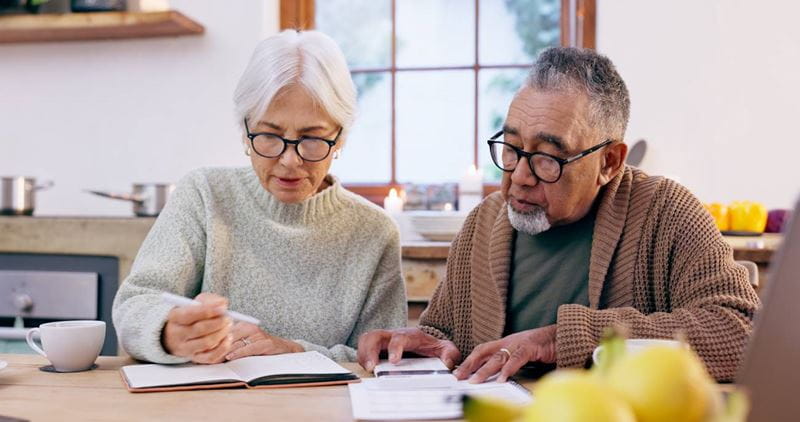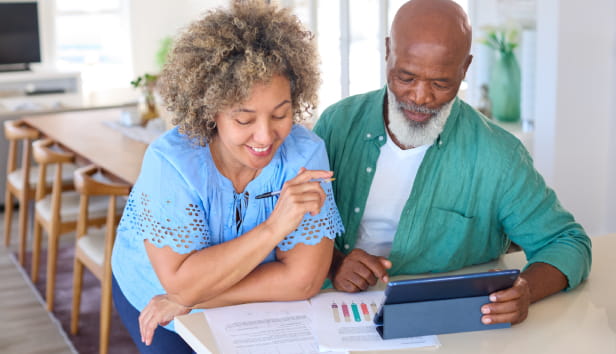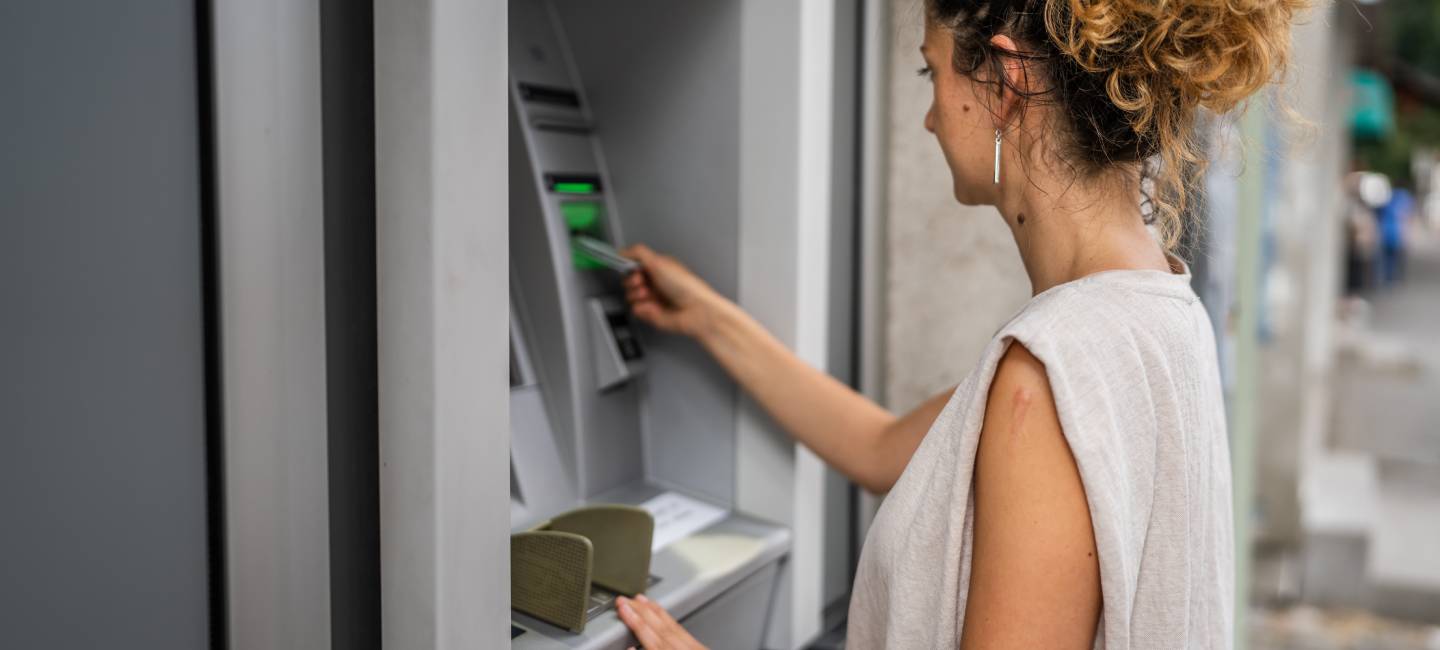This article is for general guidance only, and is not financial advice. You should always talk to a qualified professional or service to work out your specific needs before taking action on any of the information in this article - but once you've read it, you'll be in a much better position to have those discussions with the professionals. All information in this article is correct at the time of publishing, but laws, entitlements and allowances may change over time.
One of the most valuable and rewarding pledges you can make to yourself is truly taking control of your money.
As well as benefiting your bank balance, evidence shows that it can hugely help your mental health. So getting on top of your finances could really improve how you feel overall.
Below, we set out 10 of the best ways to get you into the best financial shape of your life.
What’s on this page?
The first step is simple: go back to basics. Be forensic about what goes in and what goes out of your bank account by looking at statements regularly every month.
You make a spreadsheet, or even just a handwritten list. Either way, seeing everything in black and white can make it clearer where you spend and where you can make easy savings (if that’s a priority for the year).
This might be spotting subscriptions for publications you don’t have time to read or cutting down on coffee shop lattes. You’ll soon be able to spot what’s essential spending and what’s ‘nice to have’. That can be the key to being able to make bigger changes that’ll really make a difference.
If you’ve got to grips with your spending, but don’t want to have to balance your budget in a notebook every day, there are plenty of clever third-party apps, or your bank may have one, to help you keep a better eye on things throughout the month.
If you have multiple accounts from different banks, many apps will let you see them all in one place, so it’s easier to spot what’s going on.
These budget apps generally work by letting you categorise your spend on things like bills, entertainment, savings and so on, so you’ve got a true view on what’s actually being spent.
You can either enter your spending as you go, or some will automatically pull your transactions in, if you give permission.
By using these apps, you’ll be able to keep up to date on the state of your account. Most have features to help curb unnecessary spending too, by letting you set limits on each category. If you overspend on food shopping, for instance, you’ll be encouraged to find the money elsewhere in your budget to cover it.
While these apps won’t solve all your financial needs in one go, they will help you understand where your money is going – and help you start making smarter decisions.
Spend a few hours – or a day if necessary – going through your household bills to see what services you can switch to save money.
There’s potential to save hundreds of pounds across the board, so look at
Get online to see if there’s a cheaper option.
One top tip: never to be afraid of ringing your provider and say you’re thinking of leaving, as that often triggers offers or discounts.
You might also see if there’s anything you can do to reduce your gas and electric bills. Log into your account and see if your energy provider can offer you a cheaper tariff – or use a comparison site to check across all providers to see if there are savings you can make.
If you have debts, Simon Trevethick at StepChange Debt Charity told us that anyone struggling to repay them needs a detailed budget (as explained above) to understand how much is left to go towards paying debts after essential spending.
He said: “If, after going through your budget and identifying areas for savings, you still don’t have enough to repay your debt, don’t panic, as support is available.”
If you’re struggling with credit card payments, Trevethick pointed to other cards that let you transfer the balance. He said: “Transferring a debt from a card with a high rate of interest to one with low or 0% interest could help you pay off the debt faster [but may incur a charge to do].
“But low or 0% interest credit cards are hard to get if you don’t have a good credit rating. This means you can’t rely on balance transfers as a way to deal with your credit card debts.
“If you do transfer a balance, make sure you cut up the old credit card and close the account. Otherwise, you may be tempted to keep spending on both cards and you’ll end up with two debts.”
If you’re struggling with your finances, remember that there is free help available from Citizens Advice, National Debtline or StepChange Debt Charity.
Taking the time to make sure your credit report is ship-shape could pay off in the long run, because the best deals are typically reserved for those with glowing reports.
Your credit file is checked even when you take out a new phone contract, so it’s worth knowing what information is being seen about you.
By checking your credit score, you will be able to spot and correct any mistakes – which are more common than you might think. Get a copy and you may find ways to improve your score and save money on any future borrowing.

If you have money sitting in an old savings account you opened many moons ago, you might be able to gain more interest from switching up.
Anna Bowes, co-founder of comparison website Savings Champion, told us: “Many savers fail to review or switch their savings accounts and as a result they could be missing out on much more interest.
“Many older accounts pay some of the lowest rates on the market. If you switch you can earn the interest you deserve.”
Now that interest rates have risen, it’s a good time to check what your money is earning and switch to the highest-paying account that suits your needs.
Further, according to the Building Societies Association, over a quarter of savers keep their cash in current accounts only, many of which earn no interest. So it’s wise to make sure your money is working as hard as it can. We explain more here about four ways you could boost your savings returns.
While there are many tax breaks available, there’s one that experts will instantly recommend: if you’re still working, make sure you’re paying as much as you can afford into a pension. The tax breaks are unrivalled, and it’s still worth investing hard later in life.
If you're employed, you can do it via PAYE by asking your employer to increase the amount you contribute, or you can put money into a personal pension.
You get a tax top-up when you pay money in, at the rate of 20% if you’re a basic rate taxpayer, 40% for those on the higher-rate tax band or 45% for additional rate taxpayers.
So, every £800 paid in would automatically be turned into £1,000 in your pension. Higher and additional-rate taxpayers could then claim back an additional £200 or £250 via their self-assessment tax return.
Don’t forget to use as much of your £20,000 tax-free ISA allowance as you can afford too. There are several ISA choices available, with cash or stocks and shares being among the most popular. You can have as many ISAs as you want, and you can spread your allowance across them to suit your financial needs.
Do remember that a stocks and shares ISA involves investment, which puts your money at risk, and could mean you get out less than you put in, compared to a cash ISA that offers a more stable return.
Incorrect tax codes are particularly common for those taking their pension, especially those who typically have income from lots of different sources.
As shown in our piece on how you can claw back money owed to you, a recent survey from financial services provider Canada Life showed that 43% of UK adults who checked their tax code found they were on the wrong one.
Even HMRC can get things wrong — and no one wants to pay more than they must. You’ll find your tax code on your P45, the PAYE Coding Notice sent by HM Revenue & Customs, or on your wage slip if you're still working.
Pensioners on low incomes can get help from the charity Tax Help for Older People.
Why not earn rewards on your everyday spend? You can do this in two main ways.
One is cashback schemes. Websites such as Quidco and TopCashback offer cashback if you buy online through them. Many who think it sounds like hard work – but it really isn’t. They are free to use (although you can pay a subscription for bigger rewards) and it takes hardly any time to look up your retailer on the cashback site, and then click through to the retailer site if they are listed.
These sites partner with many big and small brands, including Argos, John Lewis, Boots and B&Q. It's best to treat the cashback as a bonus (as it's never guaranteed) so always make sure you focus on the best deal for your needs, rather than those that give you the most cashback. Thinking of the cashback as an unexpected bonus means you won’t alter your shopping habits, making it easier to stay on top of your outlay and not encourage you to start spending more.
Loyalty schemes are another way of saving money on your shopping, especially if you were going to shop with those retailers anyway.
To spread the cost of Christmas, buy gifts as you go during the year. There are certain items family members will always want, so keep your eyes peeled for bargains and generous discount codes and stash away the gifts until December.
You may want to keep a list somewhere you’ll access regularly, so you don’t forget what you’ve bought - or where you’ve stored it.
Also, if you’re not spent out, consider buying up bargains in January such as crackers, decorations and beauty or skincare gift sets that are routinely heavily discounted – sometimes as much as 70%. It will ease the pressure for next year or can help with birthday gifts too.


We're here to help you make the most with your money. With a rage of financial services designed with over 50s in mind.

Find out how to check your credit score and how to improve it. This guide covers everything from checking your report to boosting your rating.



Boost your bank balance by claiming back everything you’re entitled to

How to make up to £175 in cash with bank switch offers - and the switching process is easier than you might think.
.jpg?la=en&h=650&w=1440&hash=092E39ADF11D79AAF2ABF0115A62F410)